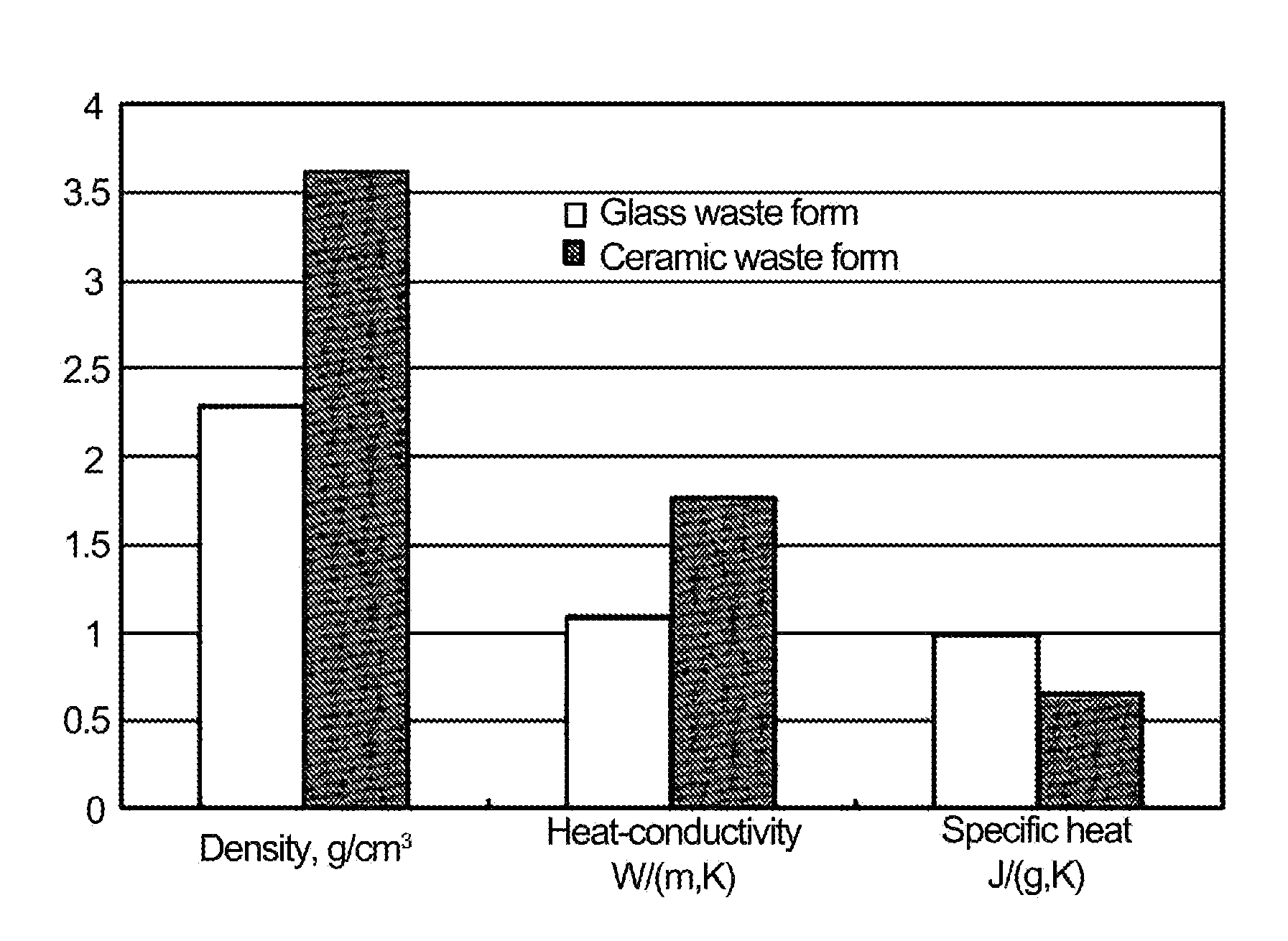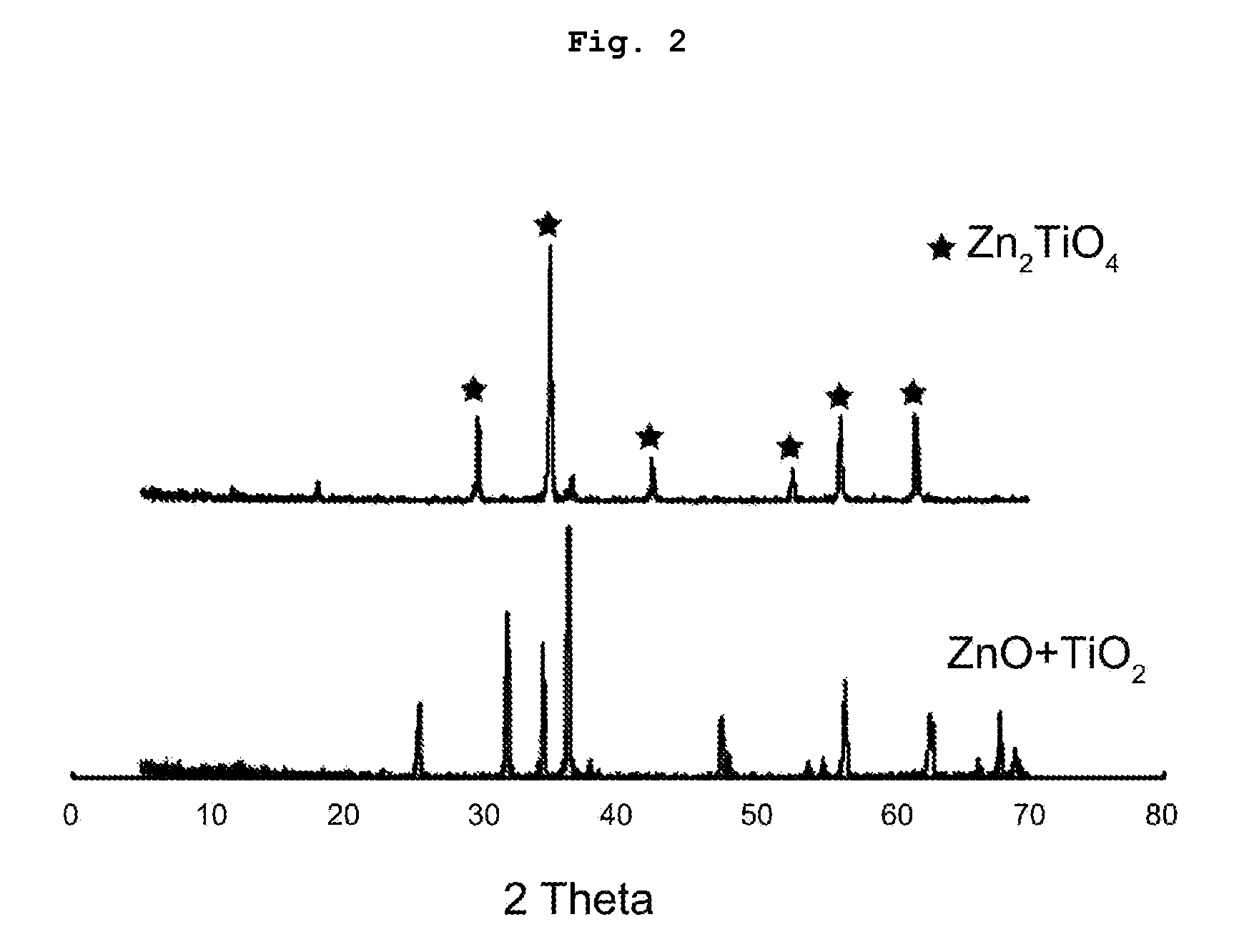Method for preparing ceramic waste form containing radioactive rare-earth and transuranic oxide, and ceramic waste form with enhanced density, heat-stability, and leach resistance prepared by the same
a technology of rare earth and transuranic oxide, which is applied in the direction of radioactive decontamination, nuclear engineering, etc., can solve the problems of many waste production, many maintenance and waste difficulties, and no research results on waste preparation, etc., and achieve the effect of increasing density, heat-stability and/or leach resistan
- Summary
- Abstract
- Description
- Claims
- Application Information
AI Technical Summary
Benefits of technology
Problems solved by technology
Method used
Image
Examples
example 1
Preparation of Ceramic Waste Form Containing Radioactive Rare Earth Oxide
[0041]42.5% Ca(OH)2 by weight was diluted in distilled water of a volume about 3 times greater than that of the material and 57.5% H3PO4 by weight was diluted in distilled water of a volume about 7 times greater than that of the compound. The two materials were added bit by bit to the dilution while stirring. The precipitate was washed and filtered at about 90° C., and dried for 2 days to prepare CaHPO4. After 67.1% ZnO by weight and 32.9% TiO2 by weight were mixed, the mixture was sintered at 900° C. for 4 hours, cooled, and ground by disk mill to prepare Zn2TiO4 such that particle diameters might be 10-60 μm. 56% and 18% of Zn2TiO4 and CaHPO4 by weight, respectively, prepared by the method, were mixed with 10% SiO2 as a commercial material by weight and 16% B2O3 by weight, ethanol corresponding to 3% of the powder mixture by weight was added to the mixture, which was later stirred by ball mill for 1 day, foll...
experimental example 1
Surface Analyses of Ceramic Waste Form Containing Radioactive Rare Earth Oxide and Glass Waste Form
[0046]The two waste forms were photographed in order to analyze the surfaces of ceramic waste form containing radioactive rare earth oxide and glass waste form, and the results are shown in FIG. 3.
[0047]As illustrated in FIG. 3, surface analyses reveal that the ceramic waste form in Example 1 had small pore size and formed dense shapes on its surface while glass waste form in comparative Example 1 had big pore formed on its surface.
experimental example 2
Analysis of Physical Properties of Ceramic Waste Form Containing Radioactive Rare Earth Oxide and Glass Waste Form
[0048]Densities, heat conductivities and specific heats of a ceramic waste form containing radioactive rare earth oxide and a glass waste form were analyzed for analysis of physical properties of the waste forms, and the results are shown in FIG. 4.
[0049]As illustrated in FIG. 4, it can be seen that the ceramic waste form in Example 1 had a density of 3.6 g / nm3, which was greater than 2.3 g / cm3 of the glass waste form in Comparative Example 1. The ceramic waste form had a heat-conductivity at about 1.8 W / (m·K), which was greater than that of the glass waste form at about 1.1 W / (m·K). It can be also seen that the specific heat of the ceramic waste form was about 0.65 J / (g·K), which was smaller than that of the glass waste form at about 1 J / (g·K). Therefore, because heat was more easily released from the ceramic waste form in Example 1 than from the glass waste form in Com...
PUM
| Property | Measurement | Unit |
|---|---|---|
| Temperature | aaaaa | aaaaa |
| Temperature | aaaaa | aaaaa |
| Temperature | aaaaa | aaaaa |
Abstract
Description
Claims
Application Information
 Login to View More
Login to View More - R&D
- Intellectual Property
- Life Sciences
- Materials
- Tech Scout
- Unparalleled Data Quality
- Higher Quality Content
- 60% Fewer Hallucinations
Browse by: Latest US Patents, China's latest patents, Technical Efficacy Thesaurus, Application Domain, Technology Topic, Popular Technical Reports.
© 2025 PatSnap. All rights reserved.Legal|Privacy policy|Modern Slavery Act Transparency Statement|Sitemap|About US| Contact US: help@patsnap.com



